Justin Robinson's Blog, page 30
November 23, 2012
A Now Fear This Roundup
I’m planning to spend most of this week digesting, and frankly, that gets in the way of long, rambling, and expletive-filled reviews. Fortunately, in the two years Now Fear This has been alive and well, I’ve written thirty-two long, rambling, and expletive-filled reviews. So this Thanksgiving weekend, if you’re looking for something terrifying to watch that maybe you haven’t heard of, browse through this list of (mostly) horror gems.
Attack the Block : Aliens attack a London slum, and it’s up to an embryonic street gang to save the day.
Behind the Mask: The Rise of Leslie Vernon : A mockumentary on the making of a supernatural serial killer in the tradition of Jason, Freddy, and Michael.
Breakdown : Kurt Russell misplaces his wife in the middle of the desert, and it’s up to him to take her back from a group of late ‘90s character actors.
The Brood : Having kids never seemed so fun and easy in this Cronenberg classic!
Brotherhood of the Wolf : Possibly the finest horror romance period piece kung fu action flick ever made.
Bubba Ho-Tep : Elvis and JFK fight a mummy in a Texas rest home.
Centurion : Extremely sexy people battle it out in Iron Age Scotland.
Chillerama : Highly offensive and extremely funny horror comedy anthology.
The Company of Wolves : Neil Jordan’s fairy tale phantasmagoria that’s probably his way of dealing with sexual abuse.
The Descent : A modern classic of survival horror so scary it barely even needs its monsters.
Dog Soldiers : Werewolves hunt British soldiers through the Scottish highlands.
The Ghost and the Darkness : Building a bridge is tough when you’re dealing with two of the worst serial killers in history who also happen to be lions.
The Gift : A creepy Southern Gothic gem from the minds of Sam Raimi and Billy Bob Thornton.
Ginger Snaps : Lycanthrophy serves as a metaphor for puberty for a pair of gothy Irish twins.
Gremlins 2: The New Batch : The anarchic sequel/parody of the horror blockbuster.
The House of the Devil : An ‘80s homage so loving it’s a wonder I didn’t dream it.
Insidious : An eerie gore-free ghost story from the guys behind Saw.
Joe Versus the Volcano : A sweet romantic fantasy about the importance of dreaming big.
The Missing : An Apache sorcerer kidnaps a girl to sell her into slavery, Cate Blanchett and Tommy Lee Jones to the rescue.
The Mist : Though adapted from a Stephen King novella, this is one of the best Lovecraft movies ever made.
Mute Witness: Hitchcockian yarn about a mute woman targeted for death by Russian snuff film makers.
My Boyfriend’s Back : It’s a one joke picture, but you gotta admit the joke is pretty funny.
Outlander : Alien Jesus + Vikings vs. Dragon.
Predators : Basically an episode of Deadliest Warrior with fucking Predators.
Session 9 : This whole goddamn movie is haunted.
Splice : Why you should never use metaphor with your mutant.
The Strangers : Lock the doors, bar the windows. Doesn’t matter. They’re already in the house.
Teeth : A young woman makes friends with her mutation. Say cheese!
Them! : ‘50s atomic horror classic about giant ants.
Trollhunter : The best found footage movie ever made.
Tucker & Dale vs. Evil : Ingenious hicksploitation parody that gives us The Texas Chain Saw Massacre from Leatherface’s point of view.
28 Weeks Later : A lesser film than its predecessor, though it still has plenty to recommend it.
Enjoy your terror!
Filed under: Projected Pixels and Emulsion Tagged: 28 Weeks Later, Attack the Block, Behind the Mask: The Rise of Leslie Vernon, Breakdown, Brotherhood of the Wolf, Bubba Ho-Tep, Centurion, Chillerama, Dog Soldiers, Ginger Snaps, Gremlins 2: The New Batch, Insidious, Joe Versus the Volcano, Mute Witness, My Boyfriend's Back, Now Fear This, Outlander, Predators, Session 9, Splice, Teeth, The Brood, The Company of Wolves, The Descent, The Ghost and the Darkness, The Gift, The House of the Devil, The Missing, The Mist, The Strangers, Them!, Trollhunter, Tucker & Dale vs. Evil

November 16, 2012
Speaking Ill of the Dead
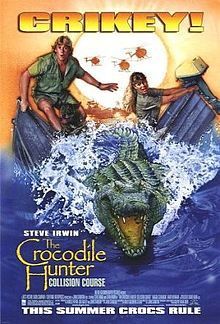
Nothing this exciting actually happens in the film.
Movies should be judged on their own merits. Just because something doesn’t measure up to the book or it stars guy who might have thought the Holocaust was the fault of someone called Sugar Tits shouldn’t impact the film as a discrete piece of art or entertainment. Similarly, just because we might have warm fuzzy feelings for someone involved, should not prevent us from ruthlessly mocking a failed bid at movie stardom. This brings me to The Crocodile Hunter: Collision Course.
Tagline: Crikey!
More Accurate Tagline: Crappy!
Guilty Party: Steve Irwin’s show The Crocodile Hunter was weirdly popular in the early aughts. Something about watching a crazed Aussie scampering around the outback accosting highly dangerous animals really appealed to the zeitgeist. I like to think it was a reaction to the War on Terror. If only we could persuade Al-Qaeda (through relentless and invasive handling) that we meant no harm, eventually things would sort of work themselves out. Opinions of Irwin are split. Some believe his conservation work marks him as the highest sort of environmentalist, while others regard his fetish for playing with poisonous fauna off-putting. When Steve Irwin died in 2006, Norm MacDonald had the best take on it: “He lived to 44 years old. That’s a ripe old age for a crocodile hunter.” I’m blaming Irwin for this movie, or more specifically his crazy level of popularity, but the insults are not at the man himself. Just the completely barking fucking mad movie version.
Synopsis: An American spy satellite falls from space and lands in Australia, where the all-important black box gets eaten by a crocodile. The CIA panics, since it contains a ton of very important information that, in the wrong hands, could alter the balance of power in the world. Since it’s never said what kind of information, I’m left to assume it’s the location of America’s strategic blowjob reserve. Anyway, they dispatch two agents, Wheeler and Archer, to get it back. Sadly, it isn’t Sterling Archer, because this movie sucks. They also send a third agent, Buckley (Kate Beahan, before she dieted herself into a Fiona Apple clone) to get it before the other two for some reason.
Meanwhile the crocodile who swallowed the beacon is also eating a rancher’s (Magda Szubanski, who you remember from the vastly superior Babe movies) cattle. She goes after the croc with a shotgun because she’s never seen that episode of Mythbusters. A guy from the Department of Fauna and Fisheries (Faramir) tells her to cut that shit out and calls in an expert to relocate the reptile.
That expert is local maniac Steve Irwin (Steve Irwin) and his wife Terri Irwin (Terri Irwin). Steve plans to leap onto the croc, grind on it a little, stick it in a box, and take it to another river, which coincidentally is how I proposed to my wife. On the way, Steve accosts the local wildlife, fondles it a little, and throws it in his truck.

Police sketch of Irwin’s vehicle.
Once he has dry-humped the croc into submission and loaded it into what can only be described as a “sex coffin,” Steve drives the animal to another river and releases it, presumably whispering, “You know what’ll happen if you tell anyone.” The CIA immediately shows up, and Irwin assumes they’re poachers. He then gleefully endangers their lives while buying time for the croc to escape.
Life-Changing Subtext: Animals can’t show where on the doll you touched them.
Defining Quote: Steve: “Croc poo!” This line is delivered with such joy, it’s disconcerting. Steve then sifts through it, just, you know, because.
Standout Performance: This is where the movie achieves greatness. Throughout, Steve and Terri do their usual Crocodile Hunter thing of speaking directly to the camera about whatever hapless animal Steve is presently tormenting. The thing of it is, no camera crew is ever established and no other character reacts to a camera as though it is present. This leaves me to assume that Steve and Terri are two deeply disturbed individuals in the midst of a psychotic break.
What’s Wrong: John Stainton, the longtime director of The Crocodile Hunter wrote this film from the panicked cries of animal attack victims. Because the Irwins are not actors, Stainton never told them the plot, instead just giving Steve a vague idea of what was going on in any given scene and letting him ad-lib. Terri gets a few scripted lines and, hoo boy, it’s tough to disagree with Stainton’s approach. What’s Wrong is fundamentally the movie’s existence. The Crocodile Hunter really had no place in a scripted film. You’d be better off using the film’s budget to fly Irwin around the world to wrestle unfamiliar fauna.

You’re Steve’s bitch now.
Flash of Competence: The croc wrestling scenes are genuinely thrilling, made better by the fact that it’s real.
Best Scenes: I was completely baffled from the word go. Irwin is introduced lunging at a poor monitor lizard who pretty much wants to be left alone. This establishes a running theme in which Steve slams on the brakes of his vehicle, hurls himself onto the ground, and then molests a poor animal into humiliated submission. In the first scene, the lizard gets away, forcing Steve to content himself on playing with the animal’s poop.
Transcendent Moment: At this point, both my readers are probably thinking I’m reading too much into this movie. Irwin’s not a molester! He’s a wildlife enthusiast whose appreciation is a tad more tactile than maybe is normal. That’s until you get to the language he uses to describe the animals. I don’t care who you are, but “beautiful sheila” is no way to describe a fucking spider. Unless, of course, you want to fuck it.
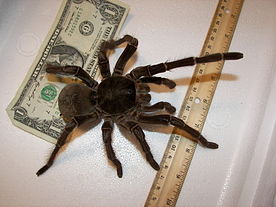
Hey, girl.
I’m not saying Steve Irwin was a threat to national security. But in the reality of the film, he attempted to murder three CIA agents who were attempting to recover data that could be invaluable to enemies of the United States. Some of it is their own fault. Once they knew he was involved, they should have found the sexiest reptile they could find, flown that big beautiful sheila in, and let Irwin grind on it a little. Then he would have given the black box back, no problem.
Do I have to think of everything?
For more bizarre movies, check out Tim’s review of Tender is the Heart. Or how about Charlie’s altogether more healthy reaction to wildlife?
Filed under: Projected Pixels and Emulsion, Yakmala! Tagged: Crocodile Hunter, possible sex criminal, spy satellites, Steve Irwin, The Crocodile Hunter: Collision Course, Yakmala!

November 9, 2012
Liner Notes: Mr. Blank
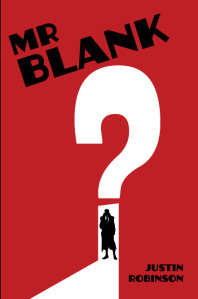
“Who’s they?”
It’s a valid question, whether someone told you “they said it would rain,” “they said to pack a sweater,” or “they blew up the Death Star.” Someone out there gave you some pretty good advice even if it’s just, “hey, you might want to cancel that vacation to Alderaan.” Regardless of the specifics, no one seems to know exactly who they are. Since no one would tell me, I figured I would eventually have to make them up.
Like a lot of people my age, I went through a conspiracy theory phase. I think this is because of the intense desire to see history not as a roiling morass of insanity, but as a consciously guided story. Even if the Secret Masters are irredeemably corrupt, their mere presence would be comforting. But then I read Fred Anderson’s Crucible of War, and if there’s one take home from the colossal clusterfuck of the French and Indian War, it’s that nobody’s in charge. This ship has no helmsman, and it’s rushing willy nilly through a field of icebergs stuffed with dynamite and Somali pirates. Go read about Tanaghrisson washing his hands with the brains of Joseph de Jumonville sometime, and then tell me about how everything is going to plan.
Conspiracy theories always have giant plot holes (it’s one of their defining features), but the one that always got my dander up was how the hell many people are employed by these things? If they’re always watching, always moving us around like pieces on a chessboard, where do they find the manpower? This would take, at bare minimum, two-thirds of the population watching the remaining third. My point is that there’s a lot of work to be done if you’re going to control the world, and not all of it is fun. And that’s where Mr. Blank comes in. Combining this manpower shortage with the idea of “they” and adding my year of working for that sociopath of a boss gave me a basis for writing the book.
At this point, I had written Nerve Zero (formerly Subspace) and had stalled out on The Dollmaker . I knew outlining was the right way to start a book, and thought maybe I should try that out. If you’re going to do a conspiracy novel, you have to have 23 chapters. There’s really no other choice there. So I wrote the numbers 1 to 23 on a blank sheet of paper. Chapter 1 would be the intro, chapter 23 would be an epilogue of sorts to mirror the first, and since chapter 12 was dead in the middle, it would be the fulcrum of the book. That’s where the mystery would get thrown into sharper relief and show Our Hero just what he’s dealing with.
A quick aside: I felt really clever having a main character without a name. It ended up making queries a royal bitch. Just know this before you decide to do it.
Anyway, I had an idea that every chapter would be an encounter with a different conspiracy and its representative weirdo. I mapped out what I thought was a more or less logical descent into the Information Underground going from relatively normal with folks like V.E.N.U.S. and the Masons to the freaks like the Servants of Shub-Internet, but that could have been the booze talking. Most of the conspiracies and groups are “real” if you go by the deity test, namely that someone, somewhere believes in them. The two actual deities that appear in some form, Anamadim and Shub-Internet, are not my creations. Shub-Internet seems to be an ironic postmodern belief, and might be better known by his titles: Eater of Characters, Beast of a Thousand Processes or the Lag Monster. Anamadim was something I found on News of the Weird, and after a descent into that terrifying subculture, I knew I had to do something with it. On the upside, I learned a couple of the spells designed to invoke her.
Initially I wanted to avoid using cryptids, but in the process of my research, I soon realized that was impossible. Every other conspiracy mentions aliens, and the big monsters like Bigfoot, chupacabra, and Nessie were all over some of the odder forays into weirdland. Eventually I just embraced it and decided the whole thing takes place in an entirely more awesome version of our world. This has led to the chupacabra becoming the unofficial mascot of the book, something which makes me deliriously happy. Maybe Mothman would make more sense, but Mrs. Supermarket has a morbid terror of him, and the idea of a Mothman plushie staring at us while we sleep is the kind of thing that keeps her up at night.
Mr. Blank ended up being the easiest book to write but the hardest to edit for a very simple reason: I wrote it basically using my own internal monologue. What you’re reading is more or less how I think, except my sense of humor can best be described as “Lovecraftian” and I have much better taste in music. I wrestled with the resolution of the mystery, coming up with two options and presenting them to Mrs. Supermarket. She emphatically chose the one in the book, which I’m pretty happy with. In any case, it’s more of a Chandler story, where the plot is somewhat incidental.
Though it took some doing to find a home for Mr. Blank, I have to say, it has the best one I could have hoped for. Candlemark & Gleam is far and away the best publisher I have worked with. It’s not just that Kate Sullivan, the head honcho and one of my editors, is a mad genius, but that as the hardest working woman in books, she focuses her terrifying brainpower for my benefit. There really aren’t enough nice things to say about her and my other editor AnnaLinden Weller. Suffice it to say if they ever need a kidney, I’ll hook them up. I can get them a kidney by three o’clock, with nail polish.
Parents aren’t supposed to have a favorite kid, but I think writers are allowed to have a favorite book. Mr. Blank is it. And because of Candlemark & Gleam, it’s also the prettiest one. Eris would be so jealous.
Check out Clint’s write-up on Wondercon, my next convention stop. Or look at Erik’s description of anti-inspiration with Vampire Dentist.
Filed under: Nerd Alert, Puffery Tagged: Candlemark and Gleam, comedy, kidney with nail polish, Liner notes, Mr. Blank, neo-noir

November 2, 2012
Very Special Blossom: Such a Night
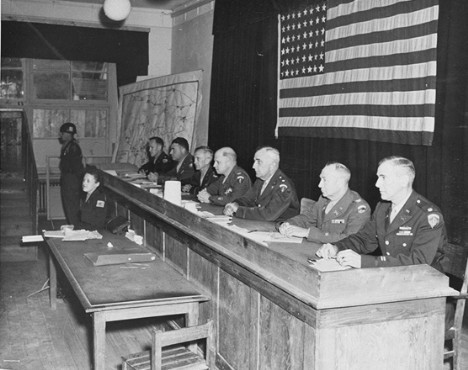
The subsequent military tribunal might have been overkill.
From the title, I figured this episode would be about sex, drinking, or sex drinking. I was kind of right, though to be perfectly honest, I figured Six would be taken advantage of at the Zeta Beta Theta house. Instead, we get a low key Friday or Saturday night in the Russo household, where the core cast pairs off and deals with hypothetical sex, hypothetical drinking, and hypothetical sex drinking.
Six is sleeping over at Blossom’s house, which for some reason involves her and Blossom spastically dancing to some canned music, although it’s also possible they’re possessed. It’s tough to tell with early ‘90s dancing. I think it’s supposed to be a reference to the credits sequence, though I might be finding meaning where there is none, like the time I thought my M&M’s were humming at me. Soon, their conversation turns to boys, specifically Johnny Depp, and what Six would like to do with his Scissorhands. It’s supposed to be funny, but I found it a tad disturbing, mostly because I’ve seen Saw.
Their plot is entirely focused around Blossom getting a date to The Dance, which seems to be her chief concern in the series. This is the second episode where a date to The Dance sets her plot in motion, making this 1/5 of her concerns on the DVD I own. Was The Dance really so important to girls that age? I would ask my wife, but as I mentioned previously, her school outlawed dance until Kevin Bacon showed up to teach them the secret of angry gymnastics. Blossom reasons that, being a feminist, she need not wait for Robert, the president of the chess club, to ask her. She can just call and ask him! In “The Geek,” I discussed the differences between the male and female dating experience, and this is Blossom’s first experience with the other side. (And not for nothing, but wasn’t she upset about dating a geek? Robert is the president of the chess club. Maybe this is a nod to slight character growth?) She calls the boy, and terrified, hangs up on him. The next time goes about the same. By the time she manages to ask him out, O. Henry has shown up and made another girl call Robert up five minutes ago (long after Blossom’s first hang up) and ask him. So if she only had the brass ovaries, she’d have a date with the geek of her dreams. The plot gets a conclusion with a light bit of homoeroticism in which Blossom and Six decide to go to the dance together.
Meanwhile, Nick and Joey are downstairs in the kitchen paying bills. Joey freaks out when they get to the phone bill and flees the room. Turns out he has been calling 900 numbers to the tune of $568. On the off chance that I’ve somehow acquired younger readers, I have to explain what’s going on here. See, before the invention of the internet, masturbation was a much more difficult and involved task. Some men resorted to calling strangers on the phone, who for a price, would describe sex acts to them. It was like sexting minus the auto-complete jokes and accidentally sending pictures of your junk to grandma. (Sorry, Nana!) Nick explains that while Joey was taken advantage of, he still has to pay the charges. Hilariously, this means going back to work at the video store, where Joey will have ample access to all the porn he wants. Not that this is mentioned.
As silly as this scene was, I’m glad they didn’t trot out the old cliche that Joey was “curious about sex.” This is one of those terms that’s like nails on the chalkboard, and really only said because adults are too squeamish to use the actual word: horny. Yes, your kid is horny. Deal with it. And kids, your parents fucked to make you. It was gross and horrible, but it happened. That’s what life is, people. A bunch of really gross stuff that keeps you occupied until the sweet release of death.

To make you feel better, here’s a fox mama and her kit.
Tony’s plot is predictably about alcohol. He begins the episode innocently sitting on the couch and watching a Laker game when there’s a knock at the door. Tony answers it to find his old friend Jeff. It’s Jeff’s alcoholic birthday, which is like a regular birthday, but with more crippling guilt and mystery rashes. He’s been sober for a full year. Tony is thrilled until Jeff invites him out for beers. Apparently, Jeff is unclear on the whole alcoholic thing as he is convinced that it’s been long enough and he can now magically handle liquor. While the plot is deadly serious, the writers desperately try to wring laughs from oblique references to how wacky the two of them used to be in their drinking days. Even the studio audience isn’t having it, offering more disgusted groans than actual guffaws. Jeff succumbs to the temptation of drink, and both Nick and Tony discuss a fear they share: that one day Tony will lose the battle as well.
My standards for comedy in Blossom are much lower than they would be for pretty much everything else. If I crack a smile, or incredibly even chuckle once, I declare the episode a winner. Not so much here. This was a slog of an episode, more interested in making Very Special points on dating, phone sex, and alcoholism. In many cases, the limitations imposed in bottle episodes often create the best examples of a show. “Duet” a first season bottle episode of Deep Space Nine is one of the best hours in the show’s entire run. “Such a Night” doesn’t come close. And not just because it doesn’t feature any war criminals.
Check out Erik’s review of a bottle movie. Or for a change of pace, how about David’s rant against large ice cubes?
Filed under: Projected Pixels and Emulsion Tagged: bottle episode, phone sex, sex drinking, Very Special Blossom

October 26, 2012
Mr. Blank Blog Tour
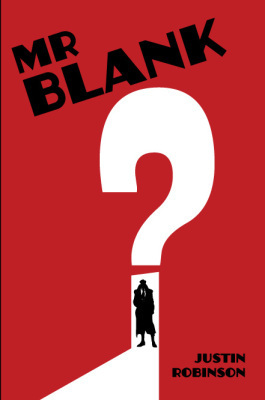
Hey, I wrote that!
My newest novel Mr. Blank was released on Tuesday to the joyous rapture of literally tens of readers. To help promote it, I’m doing something called a blog tour, where I post on a couple sites nice enough to have me. Instead of doing one of my long-winded and needlessly digressive reviews, here’s a collection of the stuff I wrote:
The mighty Bibliognome interviewed the main character of Mr. Blank. I can’t prove it, but I suspect Mrs. Supermarket is behind this booking.
The ladies over at Snobbery (you know they’re awesome because they love The Great Brain), interviewed my hero as well.
Anne Johnson (whose stuff you should check out, like now, if not sooner), graciously offered to host me. So I talked about the importance of outlining. Which, in my defense, is super important.
I thought I’d let everyone into the real story behind Mr. Blank. There’s more to it, but you’ll have to get me drunk.
And because I’m a remorseless killjoy, I thought I’d write a short history on the legend of the chupacabra.
If you want to have a party for my book, David knows how much booze you’ll need. And if a guest of honor is required, Clint talks about the only choice.
Filed under: Nerd Alert, Puffery Tagged: Anne E. Johnson, Bibiognome, chupacabra, Jester Harley, Justin Robinson, M. Fenn, Mr. Blank, outlining, SJ, Snobbery

October 19, 2012
Now Fear This: Gremlins 2: The New Batch

He really should invest in some drapes.
I watched Prometheus this weekend for the first time and was delighted and not only for the baffling character logic, the gaping plot holes, and the blockheaded pretension to intelligence. I was most pleased to discover that it belonged to one of my favorite quirky subgenres: the Christmas movie-that-isn’t. Die Hard, Lethal Weapon, and even Better Off Dead all take place around the holidays, but the connection is incidental, really only there to point out that late December in Southern California looks like spring anywhere else. Of course, sometimes the holiday is used as the impetus for the entire plot, where a well-meaning father buys his kid a gift that is way more trouble than it’s worth. But I’m not here to talk about 1984’s Gremlins since I’m pretty sure that’s considered a next tier classic in the creature feature pantheon, and pretty much everyone has heard of it. Initially dismissed as “muppets with blood,” the film took root in the subconscious of my generation, becoming at once a sentimental favorite as well as nightmare fuel. The purpose of Now Fear This isn’t to discuss movies you’ve already seen, or plan to see, or are avoiding because everyone you know is like “you gotta see this thing!” The purpose is to suggest something you might not have heard of or dismissed as garbage, and Gremlins doesn’t fit the bill. Its 1990 sequel, Gremlins 2: The New Batch does.
Gremlins was a pretty big hit at the time it came out (and along with Indiana Jones and the Temple of Doom responsible for creating the PG-13 rating, which is presently fucking up movie quality, but that’s neither here nor there), and a sequel was inevitable. Joe Dante, the director of the original, passed, feeling he’d already said all he needed to say on the subject of gremlins running amok, ruining Christmas and microwaves. Warner Brothers tried to find someone else, and when they couldn’t, approached Dante again several years later, promising him total creative control and a budget three times the size. Dante signed up, but instead of delivering a monster movie in the vein of the original, had other plans: a massive prank on the studio.
The man was serious when he said the original had a proper ending. Uninterested in following the continuing adventures of Billy, Kate, and Gizmo, Dante decided on a parody/homage, a big budget live-action cartoon to simultaneously spoof and exalt his most famous creation. He scaled the violence back, removing almost all the blood from the equation, leaving behind the muppets. The gremlins were less interested in killing people than they were in putting on short comedy sketches, referencing famous films, or performing delirious musical numbers. The gremlins were still evil, but it was a funnier kind of evil, sort of like a really good Special Olympics joke.

Yeah, that’s probably for the best.
All the gremlins needed was a new arena to play in, and Dante gave them the perfect one. This time they are in a fully automated skyscraper where literally everything can and does go wrong. The whole place acts like a giant version of one of Hoyt Axton’s inventions from the first film, down to the frequent malfunctions. The irony of it all is that the building was already in chaos before the gremlins even showed up, although their arrival does speed things along a bit. Though there’s a lot of comedy to be had from the jinxed environment, Dante seldom lingers on any one snafu, giving the impression that this whole house of cards is about five seconds from exploding into confetti and whipped cream. Additionally, the automated building speaks to people in smarmy pre-recorded messages, forsaking brevity for some bizarre sense of friendliness. This has the effect of making the skyscraper seem like the kind of casual acquaintance who stands too close and makes uncomfortable eye contact while he asks about your recent colonoscopy. The long-winded and philosophical fire alarm in particular is one of the funniest goddamn things I’ve ever heard in any movie.
Billy, Kate, and Murray Futterman are back to fight the gremlins, but Dante is not that interested in his human protagonists. He’d rather spend time with his gremlins, and almost seems to resent the heroes when they try to stop the little monsters from having so much fun. Gizmo is less of a presence here, relegated mostly to being tormented by three of his original progeny, and later in a series of short training scenes. He rescues Kate (and gains fiery revenge), but he is no longer the hero of the film.
Dante’s allegiance lies with the gremlins to such a degree that he gives them a voice. The skyscraper includes a genetic engineering lab, presided over by horror superstar and actual killer of Germans Christopher Lee. Once the gremlins get in there, they begin modifying themselves with bizarre results. None change moreso than one, who after drinking a brain hormone, suddenly gets glasses and speaks in Tony Randall’s voice. Brain Gremlin gets the film’s best lines, and remains the architect of my fundamental view of economics. Only two things in the world have intrinsic value: canned food and shotguns.
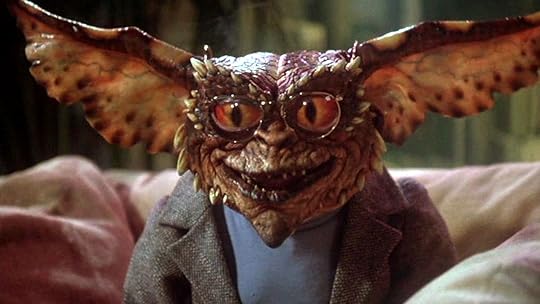
The greatest philosopher of this, or any other age.
There are numerous callbacks to the original film, but they take the form of parody rather than the natural escalation of a sequel. Gremlins attack a woman in the kitchen, only this time, it’s Microwave Marge, the pissdrunk host of a cooking show. Kate has a dark association with a holiday, but this time it’s ridiculous. They even lampoon Leonard Maltin’s poor review of the original film by having him on to get his comeuppance.
The effects have improved as well. The original gremlin puppets were the work of Chris Walas, the effects man behind the Cronenberg masterpiece The Fly. He passed on Gremlins 2 to direct The Fly 2, a film I will not be profiling on Now Fear This. Rick Baker agreed to build the gremlin puppets, only once he was assured that he could create greater variation amongst the monsters. This is a bit like losing Kobe Bryant to free agency and somehow winding up with Kevin Durant. The creatures are a triumph of puppeteering, with incredible range of motion, facial expression, and malevolent life. The only rough spots are the few attempts to show a complete shot of Gizmo walking or dancing. The technology isn’t quite up to the task, but I give them points for trying.
Gremlins 2 is the rarest kind of sequel: one that doesn’t give a flying fuck if you liked the first one. Because of this, and the six year wait between films, it was initially dismissed. Since then, its cult has been steadily growing. It’s a good idea to join now, if only so we can finally get our rendition of “New York, New York” going.
Filed under: Projected Pixels and Emulsion Tagged: awesome, Brain Gremlin, Gremlins 2, Joe Dante, Now Fear This, parody

October 12, 2012
Now Fear This: Trollhunter

Troll!
By the time Psycho came out, color was the norm. Hitchcock chose to shoot in black and white for two reasons. The first, and most important, is that he was insane. The second was that he was a genius. See, Hitchcock knew something very important: we don’t look at films the way we perceive reality. At the time, newsreels in movie theaters were black and white, so despite the world actually existing in color (as it had since at least, like, the Crusades or something), shooting Psycho in black and white would link it with the news in the subconscious of the audience, and thus something that actually happened. By making it less realistic, he was able to make it more real.
My first encounter with found footage was Man Bites Dog, a 1993 Belgian mockumentary about a serial killer. I remember liking it a great deal and still even occasionally reference it, though no one else knows what the hell I’m talking about. Soon after, like almost everyone else at the time, I saw The Blair Witch Project. Peer pressure’s a bitch. Anyway, I discovered it organically, just like Artisan’s marketing department wanted me to, first as rumors circulated breathlessly by my friends. I never once thought Man Bites Dog was anything but fiction, but Blair Witch had me going until I sat down to a bootleg screening at a friend’s house and started to see the cracks in the storytelling. Both films were interesting primarily for what they said about the way we perceive our world. Video cameras (or portable television studios, as Doc Brown might say) had been around for awhile, but they were expensive and bulky extravagances. The technology had gotten both cheaper and smaller, meaning that recording devices were just starting to become ubiquitous. We were beginning to see our world through the lens of a camera.
I am a bit of a sucker for found footage, which plays in the same arena Hitchcock did. Some of it is the genuine love I have for low budget filmmaking, in finding the creative ways they work around having no money. Some of it is that found footage helps do a bit of the heavy lifting when it comes to suspension of disbelief. And some of it that is when done well, there is nothing quite as thrilling. There might be no better example of found footage done well as 2010’s Trollhunter.
The film begins almost exactly like Blair Witch with a group of college students doing a film project. In this case, they are investigating a possible poacher among the local bear hunters. This is a good time to mention that the film takes place in Norway, the land of vikings, and apparently their idea of a good time is still going out and hunting the number one threat to America. The hunters, without exception, are suspicious of a man named Hans, believing him to be either a poacher or not a bear hunter at all. The crew immediately turns to investigating Hans, discovering his reeking floodlight-covered trailer, his Land Rover covered in long rents like claw marks, and that he stays out all night every night. So either he’s operating some kind of mobile disco for grizzly bears, or he’s up to something equally unsavory. The plot thickens as another possibly poached bear is found near where Hans was last seen, and it is surrounded by tracks the local hunters swear could not have come from the animal.
The crew tails Hans one night to a back country road, which is closed with a No Trespassing sign and follow him out into the Norwegian woods, fueled only by journalistic courage and queasy jokes. Eventually, they begin to hear odd sounds in counterpoint to flashing deeper into the forest. As they grow closer, Hans rushes from the trees shouting, “Troll!” The crew flees in panic, and on the way out of the woods, they pass their car, which has been totaled and is covered in some kind of slime. As things calm down, Hans agrees to take the crew out the following night, only after extracting a promise that they will obey him no matter what. On this hunt, Hans finds his quarry from the previous night, a three-headed troll. It is at this point that shit gets real for the crew. In the midst of panic and hiding from the tree-sized beast, they film Hans grumpily battling and eventually killing the monster with focused UV light.
Hans is a troll hunter employed by the Troll Security Service, a government agency in charge of safeguarding the citizenry from these not-actually-mythological creatures. Hans dryly explains (with all the interest of a plumber going through the kinds of drain clogs) that trolls come in two major varieties, mountain and woodland trolls, which are further split up into species with evocative names like Rimetosser, Ringlefinch, Mountain King, and Jotnar. His businesslike comportment and working class weariness defines him: any wonder he once experienced at seeing these magnificent animals has entirely vanished. He sees them as disgusting and stinky behemoths to be destroyed, and then cataloged on the bureaucratic forms that provide one of the film’s sharpest gags.
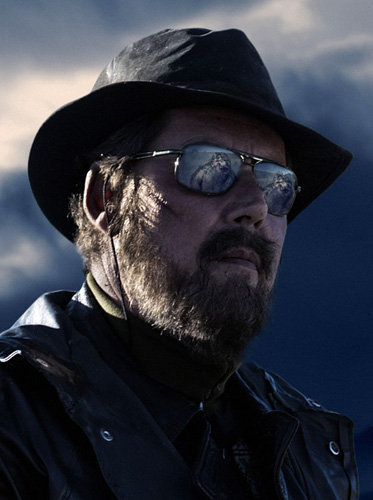
“I’ll find him for three. But I’ll catch him, and kill him, for ten.”
Blue collar heroes struggling against the supernatural is another of my favorite tropes. It’s probably inevitable for any child of the ‘80s to attach particular resonance to Ghostbusters and its spiritual children. Though I have nothing against someone fighting the darkness because it’s The Right Thing To Do, taking on the same challenge for a small paycheck is infinitely more appealing. What kind of person does that? Even in this economy, they have to be qualified for something slightly less dangerous, right? And let’s be honest, treating something as bizarre as hunting trolls, busting ghosts, or slapping werewolves as just another day at the office is funny as hell. Trollhunter is not a comedy the way Ghostbusters is, but it has a great deal of fun with the legends surrounding trolls, the tools and methods you’d use to effectively fight these monsters, and just how stupid these things really are. The man playing the titular trollhunter, Otto Jespersen, is a comedian in Norway. I have no idea what his act is like, but he plays this role role with deadpan seriousness. It’s the perfect decision, giving the character both gravitas and making him seemingly unaware of how bizarre his life truly is.
From everything I’ve read, Trollhunter contains numerous references to Norwegian culture and folklore. You don’t have to understand these callbacks to appreciate the film; it’s a fine piece of work regardless. The mere presence of these idiosyncratic moments serves to give the movie depth, so even as we foreigners don’t truly understand, we can see the craftsmanship on display. The best moment is the last shot, as the filmmakers somehow manage to steal a truly incredible quote from an elected official.
Erik discusses a decidedly non-working class hero, or check out the Now Fear This that kicked off last October! Or you could see Clint’s review of Trollhunter over on his other blog.
Filed under: Projected Pixels and Emulsion Tagged: Norway, Now Fear This, troll, Trollhunter, Trolljegeren 
October 5, 2012
Liner Notes: The Dollmaker

Cover by Charlotte Volnek. Neat, huh?
This is the one that was never supposed to be published.
It started as a writing exercise. Something weird and dark that I could use to practice horror. My first records of The Dollmaker consist of an email I sent to myself of the first part of the first chapter, namely the rite Stephen Monaghan uses to bring his first doll to life. It appears in the book more or less how I wrote it (although my editors really helped smooth it out because for certain words I apparently have some variant of Tourette’s). And appropriately enough, the date of the email was Halloween.
The Dollmaker started life as only a series of nightmarish images. I could see certain things perfectly clearly: portions of the very end, the Innocent crawling from the darkness, the Firstborn alone in the house. And that’s what I wrote, isolated scenes with only a vague idea of how to connect them to a larger narrative. It functioned on a sort of dream logic, which is a fancy writerly way of saying it made no fucking sense even if at times it kind of did. I was fine with this, because the book was never supposed to see the light of day, and thus never had to be finished.
Eventually, I wanted to write a book that could be published and start a career in a dying art form that could inevitably end with me dead in a pool of whiskey vomit. And this time, damn it, I’d do it right with an outline and stuff. So I wrote Mr. Blank. And then, for reasons I’ve already gone into, I wrote Undead On Arrival. When that was done, it really felt like I was trying to get an actual writing career going, even though my success to that point could be best compared to North Korea’s space program. Looking for projects, I returned to The Dollmaker with a better idea of how to finish a book. I took what I had, put it in some order, and outlined some connective tissue to try to tie it all together. As it turned out, I had a bit of a trainwreck on my hands. Characters went nowhere, there was no real villain, and I had only the vaguest idea of how everything wrapped up.
What I needed to do was really think about what I was trying to do here: take a nightmare and add a plot. My primary influences were The Hunger and Cat People, a couple of horror films from the early ‘80s and highly sexualized takes on classic monsters. The irony is that both of these films are failures, albeit fascinating ones, more compelling for what they attempt than they accomplish. I would add a Frankenstein tale to complete the trilogy, and use some of the same genre hallmarks, including ‘80s style markers, a hyper violent scene in a strip club, and most importantly, the scuzzy grandeur that makes even such flawed films resonate.
Even more importantly, what the hell was I trying to say? I started with the central metaphor of creation. Normally that requires two people (implying the only difference between human and divine is how many folks creation needs, and explains the Gnostic conception of the creator), but here was one person. Because my protagonist was a man, I had to relentlessly feminize him, both socially and symbolically. And I also knew this would disturb the hell out of any male readers, and disturbing people is sort of a horror writer’s raison d’etre.
Since you can’t actually make wooden people who think, magic had to be part of the story and magic has to have a cost. As soon as it does not, the drama bleeds out of the story. There are tons of different costs, including social, physical, spiritual, and probably others I don’t have the imagination to come up with. I was fascinated by the idea of a formerly unliving object becoming a person. One minute it’s a block of wood; another and it’s a person with thoughts and dreams. This informed the cost. Their souls, for lack of a better term, had to come from someplace, and though I never wanted to definitively answer where, I knew that the cost should be somewhat similar. So I started robbing Stephen of the markers that made him an individual. Anything that could identify him, from his signature to his blood type to his shadow, had to go.
The dolls originally had names. Stephen christened each one, but it quickly became apparent that it wasn’t working. There was something faintly ridiculous, at least in my mind, of these creatures addressing one another by human names. I hit on the solution when I was researching the golem myth. In some stories the creature had the Hebrew word for “truth” inscribed on its forehead. While Stephen would never mar his perfect women with something like that, drawing it on their tongues seemed to be a good solution. And when someone has a marking like that in the language of God, they should have a special connection to the truth. This is where the dolls’ ability of “naming” came from, as well as their certain fatalism.
Brian’s character evolved, or rather devolved, with each draft. Part of the original idea was that everyone was going to have some kind of sexual dark side to echo Stephen’s (showing he’s not quite as alone as he thinks), and some of these made it into the final draft, including Milena’s prostitution, Tyler’s extremely specific and exclusionary sexuality, and of course Brian. He was initially far more innocuous, but as I realized that I needed a villain, Brian turned into Stephen’s dark reflection, and since Stephen was already pretty dark, Brian had to be much worse. So while Stephen was sort of effeminate, Brian had to become hyper-masculine. He took the place of the villain, while his plot pretty much progressed as I envisioned it from the beginning.
The second draft was terrible. I sent it to two readers, one of whom hated it. The other loved it. Said it was the best thing I had written. I was flabbergasted. So I wrote another draft and sent it to more readers. And another for even more readers. The response grew more positive with each draft, although women had a stronger reaction toward it (positive and negative) than men. I had it in the back of my mind to shop the fourth draft, but Undead On Arrival had seniority. A friend sent me a list of publishers who had good reputations, so I planned to query from the top down. The first one only did romances. The second was Muse It Up. I had a look at what the editors wanted, and one said something to the effect of, “I want something extremely dark that will haunt me.” I shrugged and was like, “Well, you asked for it.” After my mountain of rejections for all three previous books, I wasn’t holding out much hope. Until Sunday night after Comic-Con 2011, when I checked my email, finding a message from Muse requesting a simple rewrite before they would accept the manuscript. A little more than a year later, and The Dollmaker was out.
Like I said, this is the one that was never supposed to be published, and it was the first to find a home with a pretty well known small press. So I guess the lesson is, if you feel you have to write something, do it, and worry about where it’ll sell later. I have rewritten it so many times I can’t look at it even remotely rationally, so I hope it’s as coherent as anything like it can be. On that subject, I once tried to explain the book to my wife by telling her, “It’s like one of those sex dreams that becomes a nightmare halfway through.” She gave me a blank look and said, “Yeah, I don’t get those.” And that, creatures, is the whole point.
Check out Erik’s take on Jaws the Revenge or for more from me, have a look at the Liner Notes from my other book.
Filed under: Moment of Excellence, Nerd Alert, Puffery Tagged: body horror, Frankenstein, golem, gothic horror, horror, Liner notes, The Dollmaker

September 28, 2012
The All-Singing All-Dancing Crap of the World
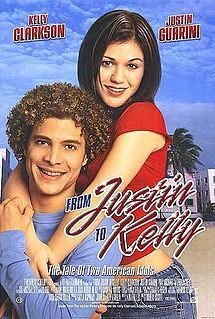
Somehow those smiles are the least artificial things in this movie.
In 2002, a craze swept America. Everywhere, people could speak of only one thing in the hushed tones of wonder. On every pair of lips was a single name, repeated over and over until the syllables lost all meaning: “Dunkleman.”
Dunklemania, as later historians termed it, was either a mighty tide sweeping the culture toward decline or it was the first step toward universal peace and enlightenment. It might have also been bullshit. For those few who missed it, Brian Dunkleman was the co-host, along with his lesser known colleague Ryan Seacrest, of big-budget karaoke contest American Idol. The photogenic winner and runner-up of the inaugural season were quickly wrapped up in legal red tape to appear in a tie-in film: 2003’s From Justin to Kelly.
Tagline: The tale of two American Idols
More Accurate Tagline: The embarrassing contractual obligations of two American Idols
Synopsis: Kelly (Kelly Clarkson — what, you thought it would be Justin?) sings and waits tables in an empty honky-tonk. Her only fan is redneck Luke, who wants to be more than fans. He definitely wants to hold her hand, and might even want to kiss. Anything more transgressive is out of this movie’s vocabulary. Kelly’s two friends Alexa and Kaya want Kelly to go with them to party in Fort Lauderdale over spring break. She agrees, despite the dialogue constantly reassuring me that if Kelly were any more chaste and pure she’d be saving Swiss children from Nazis.
Justin (Justin Guarini) is the leader of the “Pennsylvania Posse,” a group of Penn students who view spring break as a capitalist enterprise and presumably an escape from the nightmarish sexual abuse they suffer in school. The film subtly implies Justin is no longer the carefree player by having Justin state repeatedly to a variety of characters that he is no longer a carefree player. He does not have a song about it, because as stupid as that dialogue is, it is not stupid enough in the context of the film to require singing.
During a song and dance number on the sandy beach, Justin and Kelly have a spastic love connection. Justin senses that Kelly is not like the other girls. Maybe because she’s the only one not in a bikini? Maybe Justin has the extremely specific power of seeing into the hearts and souls of other American Idol finalists? Maybe because the writer cannot be expected to bridge the toxic anti-chemistry coursing between the leads? Justin gets Kelly’s number, but it is immediately destroyed. He manages to find Kelly’s BFF Alexa, who is a skinny blonde Paris Hilton type, down to the likely herpes simplex. Instead of giving him Kelly’s number, she gives him her own, and this is the entire conflict of the “plot.”
Meanwhile, their friends are having their own misadventures. Nerdy Eddie looks for a girl he met online, which is laughable because ha ha, he can use a computer. Kaya dates local waiter Carlos, and a few minor class-related differences inconvenience their budding relationship. Brandon is dogged all over the beaches by sexy Officer Cutler, who seems to exist only on the unfulfilled promise of a striptease.

Rumors that she’s a Hot Cop remain unsubstantiated.
Justin courts Kelly with dulcet text messages like, “IOU A BRGR U GAME?” Seriously, suck a dick, Shakespeare. You can’t compete with poetry like that. How could any woman ever resist such honeyed words? Alexa uses the phone to fuck with the both of them, sending Justin blow off texts ostensibly from Kelly and making Kelly think the broccoli headed man of her dreams won’t call. Why is Alexa doing this? Who knows? In a stunning third act reversal, she claims it’s out of jealousy, and makes amends by reuniting the two of them for a final kiss. Things work out for Kaya and Carlos, Eddie and his internet hookup (who looks closer to retirement than college), Brandon and Officer Cutler, and in the final scene, even villain Alexa seems to find a man.
Life-Changing Subtext: Friendship is more important than that friend betraying you for shits and giggles.
Defining Quote: “You’re the mayor of spring break, and she’s one-bonnet-shy-Amish.” — Alexa, to Justin. A lot of hay is made of Justin’s supposedly sordid past, but this guy couldn’t be more wholesome if he were perpetually guzzling milk and helping old ladies with their heavy parcels.
“We made a very nice connection in that bathroom.” — Justin, about Kelly. This is a close second, and the less explanation the better.
Standout Performance: I’ve seen better acting in grade school seizures.
What’s Wrong: Clint recently discussed (and I previously alluded to) the most ironclad rule of the musical, Voltaire’s pithy, “Anything too stupid to be said is sung.” What if literally everything in the movie is too stupid to be said, and yet somehow there’s still dialogue?
Clint also points out that a good musical has songs come from the environment depicted. What if that environment is chiefly has shitty music? So on one level From Justin to Kelly succeeds. On another, very real level, it fails harder than Todd Akin in an 8th grade health class.
Flash of Competence: Justin and Kelly have nice voices. Oh, and Kelly has cute hair.
Best Scenes: The film boldly opens with an attempt to alienate as many people as possible with a Kelly Clarkson cover of “Vacation.” Don’t fuck with the Go-Go’s, Kelly. Wiedlin alone own you in a coke-fueled pixie rage.

Pictured: Coke-fueled pixie rage
At their second date, Justin takes Kelly out on a boat, presumably because of the implication. They ignore each other to sing a song of longing. Which would work, if there were anything standing between them. There’s not. He likes her, she likes him, they’re both single. It’s just that he has the wrong phone number. Which wouldn’t even be a problem if they’d just, you know, turn the fuck around and talk to each other. God, some real conflict would be fantastic. Would it fucking kill this movie to introduce some villainous drug smugglers?
Transcendent Moment: In the midst of this non-conflict, Kelly’s stalker Luke shows up to try to win the woman of his dreams. He and Justin square off, ready to have a PG rated fistfight. That’s when someone apparently replaced the screenwriter’s Diet Coke with pure LSD.
Because a simple fight isn’t how these guys solve their differences. Nope. Time for a hovercraft fight. And it’s not even what you’re thinking, which is either two guys ram into each other on hovercrafts, or they use them like giant clubs. No, this turns into more of a carnival game, and the worst part is neither one gets molested by a toothless guy behind the tilt-a-whirl.

He said he loved me.
From Justin to Kelly is a failed attempt both to cash in on a successful series and groom these two as possible movie stars. Now it’s a curiosity that exists only to ensnare masochists like me.
Check out Erik’s piece on musicals, or have a look at a review of a far more entertainingly terrible musical.
Filed under: Projected Pixels and Emulsion, Yakmala! Tagged: American Idol, From Justin to Kelly, Justin Guarini, Kelly Clarkson, musicals, Yakmala!

September 21, 2012
Very Special Blossom: The Geek
Then again, maybe it would have saved some heartache. In high school, I learned how to conceal two things: crippling emotional pain and boners. Dances were concrete events that would tell me that I didn’t have a girlfriend. Not that I needed reminding, but it was always nice to hear. So while most dances were being held I stayed home and was generally bitter about the whole thing. It’s even more ridiculous once you realize that not only am I entirely incapable of dancing, I don’t like it, and hated the kind of music they played. Really, I was angry that I didn’t have a girlfriend, because no matter how shitty the music, no matter how arrhythmic the thrashing, there’s very little emotional turmoil that can’t be soothed with a little grinding.

Dear god, no.
In this week’s Very Special Blossom, “The Geek” (season 1, episode 8), I got to watch the whole situation from the other side. Until now, I was concerned with the boy’s view of dating, which is sort of like playing chess blindfolded while girls laugh and throw things at you. We have to suss out who might be interested, then swoop in without being total dorkwads about it, and get through an entire dance while hiding a priapism that’d put most fertility gods to shame. For girls, apparently, it’s about the agony of waiting to be picked. You have the alpha male douchebag of your dreams, but will he be the one to ask you? Or will you have to settle for a beta who actually knows your name?
The episode begins in Blossom’s school whose narrow hallways clearly mark it as a soundstage. She and Six are both panicked because neither one has a date. I actually understood the fear. This was back in the early ‘90s, which meant that a night at home was only as good as whatever the TV gods saw fit to put on. If you were lucky, you’d get a Police Squad! marathon. Unlucky? Nothing but that fucking Dudley Moore movie where his daughter dies of ice skating. Blossom and Six are horrified that they might be known as the “girls with the good personalities.” Good to know that euphemism has been a hacky joke for nigh on twenty years.
Salvation appears as a bolt from the blue in the form of Jordan Taylor. Confusingly, he’s played by Justin Whalin, who alert readers will remember as William Zimmerman from the very special pilot. Back then he was a mousy guy wrapped in an oversized Cosby sweater. Here he has hulked out with puberty, completing the most upsetting transformation since Anthony Michael Hall played the bully in Edward Scissorhands. The weird part is I’d swear Whalin is wearing Hall’s letterman’s jacket from that movie, despite no one actually wearing those after 1985. Whalin asks Blossom to the dance, but pulls a bait-and-switch with class nerd Fred Fogerty (played by Chris Demetral, probably most famous as the son on HBO’s Dream On). So now Blossom has a date to the dance, but it’s with someone her mentally-challenged brother describes as “the lovechild of Olive Oyl and Gilligan.”
At first, Blossom is prepared to grin and bear it. After all, this is a middle school dance, it’s not like she has to touch the guy’s dick or anything. (The show didn’t put it like that; I’m just saying.) This is until she talks to Joey, who convinces her that one date with “Pinhead Fred” will irrevocably destroy her social life. He counsels her that despite the fact that she’s in the honor society, plays the trumpet, and “has not been blessed by the hooter fairy yet,” she’s a borderline babe. I’m not here to quibble about Mayim Bialik’s attractiveness, but the honor society and trumpet things are points in her favor. Sure, the cello is hotter (all strings are), you can make do with a brass instrument. Plus, this was the early ‘90s. How many guys were just getting their ska bands off the ground? Do you have any idea how an all-female horn section would have played?
Other than the fashions, there is nowhere that Blossom shows its age more than in the surreal guest star-studded dream sequences. These are on the edge of the randomness and irony that next generation sitcoms like Scrubs or Malcolm in the Middle would mine, though lacking the madcap go-for-broke qualities these shows had. Plus, who they decide on as a big enough name to anchor the scene says it all. In “The Geek,” that guest star is Alf.
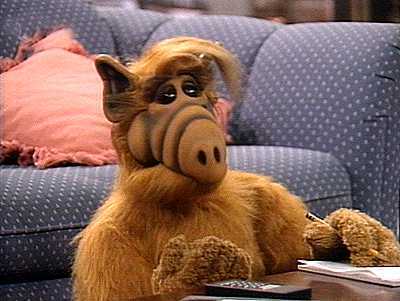
This guy.
Yep, everyone’s favorite Melmacian shows up as St. Peter to kick Blossom out of heaven for dating Pinhead Fred Fogerty. You would think that a couple sympathy gropes would put her on the VIP list, but no. She forgot the 11th Commandment, which is apparently, “Thou Shalt Not Geek.” This would have meant something completely different as early as thirty years before the episode aired, but hey, if we didn’t misinterpret Bible verses based on modern social mores, we wouldn’t have the religious right.
In 1991, Alf had the status of the Oracle of Delphi, because the next day Blossom breaks her date with Fred. She doesn’t even take the time to come up with a story, instead sputtering out some preposterous nonsense about a weekend trip to Bulgaria for something called the International Trumpet Festival. Fred sees through it and is crushed. Although not as crushed as Johnny Galecki, who is conveniently ignored as a possible date, perhaps because of the embarrassment suffered only three episodes ago.
In what is already a series trope (based on my limited sample of roughly half the episodes aired), Blossom has a late-night soul-searching conversation with recovering alcoholic Anthony. The scene is notable for several reasons. One, I have no idea what the hell Anthony is supposed to be eating. It doesn’t even resemble food. Two, he refers to an ATM as an Automated Teller Machine, suggesting the initials weren’t in common enough parlance for the writers to be certain we knew what that was. And the last is Anthony’s theory about geekdom. He points out the same thing my mother used to tell me: geeks are late bloomers. (Incidentally, I’m still waiting to bloom, mom. Let me know when that’s supposed to happen.) The world is run by geeks, Anthony reasons, and it’s the early rejection that fuels them to greatness. And then he says something that history has rendered deeply ironic. About Blossom’s conundrum, he opines that, “Woody Allen’s date for the prom had the same problem.”
[image error]
…Fred Fogerty is Blossom’s dad?
Blossom decides to do the right thing and goes back to Fred. He, however, decides to be awesome, calling her on the story and asking if she’s suffering a delusion that she’s super cool. He has become accustomed to rejection, but it hurts more coming from someone like her, who he used to have a high opinion of. Then he walks away. That kid has shit figured out. And when he’s a software billionaire by twenty-eight and plowing through Russian models, he can be the toast of the reunion. For now, Pinhead Fred waits and plots his vengeance.
Clint talks about how to deal with Alf if you ever run across him. Or check out another take on the same subject.
Filed under: Projected Pixels and Emulsion Tagged: Alf, Dream On, geeks, prom, Very Special Blossom




